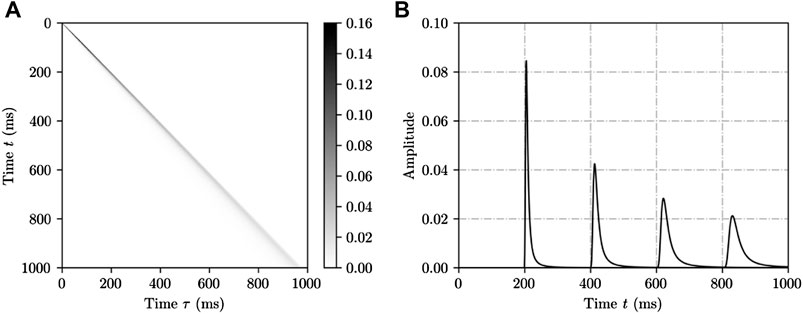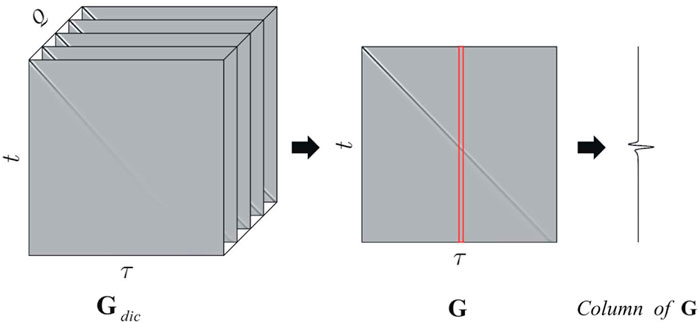- 1Key Laboratory of Petroleum Resources Research, Institute of Geology and Geophysics, Chinese Academy of Sciences, Beijing, China
- 2Innovation Academy for Earth Science, Chinese Academy of Sciences, Beijing, China
- 3College of Earth and Planetary Sciences, University of Chinese Academy of Sciences, Beijing, China
The seismic reflectivity and quality factor Q play an important role in seismic processing and interpretation, such as improving the resolution of seismic data and enhancing the reservoir identification. Most methods estimate seismic reflectivity and Q separately. However, the error of Q model has a negative impact on the reflectivity estimation and the interference of reflectivity makes Q estimates less reliable. In this paper, we propose a new method for concurrent estimation of seismic reflectivity and Q by using optimal dictionary learning. This new method first constructs a complete dictionary based on the non-stationary convolution model, then computes the reflectivity series under different dictionary matrices with the corresponding referencing Q values, and finally selects the optimal dictionary matrix by comprehensively analyzing the residual and reflectivity sparsity so as to obtain seismic reflectivity and Q simultaneously. The results of synthetic and real data examples test confirm the effectiveness of the proposed method. The proposed method provides accurate estimation of seismic reflectivity and Q, improves the vertical resolution without losing weak events and offers more accurate information concerning stratigraphic features in great details.
1 Introduction
Seismic attenuation is ubiquitous because of the earth anelasticity, and it can lead to amplitude decay and phase distortion of the seismic wavelet (Futterman, 1962). The seismic quality factor Q, an important parameter for characterization of rocks, measures seismic attenuation. Seismic reflectivity and Q are sensitive to the geologic information such as lithology and fluid (Winkler and Nur, 1982). Hence, accurate estimation of seismic reflectivity and Q has an important role in seismic processing and interpretation, such as improving the resolution of seismic data and enhancing the reservoir identification.
Seismic reflectivity is commonly computed by the deconvolution methods based on the stationary convolution model, which assumes that the stationary seismic data as input (Velis, 2008). Therefore, the seismic data should be compensated for the anelastic attenuation effects before using the conventional methods to estimate reflectivity. Margrave (1998) extends the stationary convolution model to a non-stationary one by the constant Q theory (Kjartansson, 1979). And then Margrave et al. (2011) develop a non-stationary deconvolution method that estimates reflectivity using the Gabor transform. This method requires non-stationarity propagating wavelets. Chai et al. (2014) present a non-stationary sparse reflectivity inversion method to estimate reflectivity. The non-stationarity seismic data is addressed by non-stationary deconvolution so as to estimate the seismic reflectivity, but the Q value need to been estimated in advance. The computational accuracy of the seismic reflectivity depends on the estimated Q value.
Many methods have been proposed for Q estimation from seismic data, such as the spectral ratio method (McDonal et al., 1958; Hauge, 1981; Blias, 2012; Reine et al., 2012; Nakata et al., 2020), the matching method (White, 1980), the amplitude decay method (Tonn, 1991), the analytical signal method (Engelhard, 1996), the frequency shift method (Quan and Harris, 1997; Zhang and Ulrych, 2002; Gao and Yang, 2007; Hu et al., 2013; Matsushima et al., 2016; Li et al., 2020; Yang et al., 2020), the Q-tomography method (Brzostowski and McMechan, 1992; Dutta and Schuster, 2016) and the Q-analysis method (Wang, 2004; 2014). Among the above-mentioned methods, the spectral ratio method and the frequency shift method are widely used in practice, which estimate Q values by comparing the frequency content of two individual waveforms at different depths or time levels. These methods suffer from the problem of instability because they are very sensitive to layering effects and random noise.
Most methods estimate seismic reflectivity and Q separately. However, the error of Q model has a negative impact on the reflectivity estimation (Shao et al., 2019), and the interference of reflectivity makes Q estimates less reliable (Hackert and Parra, 2004; Xue et al., 2020). Gholami (2015) proposes a semi-blind non-stationary deconvolution method to determine both the reflectivity and Q models simultaneously. And then Aghamiry and Gholami (2018) develop this method for interval Q estimation based on the adaptive parametric dictionary learning. This method only uses the sparsity of the earth impulse response to determine the Q model.
In this paper, we propose a new method to estimate the seismic reflectivity and Q concurrently by using optimal dictionary learning. First, we review the basic theory of the non-stationary convolution and introduce our new method. Then, we test the new method for seismic reflectivity and Q estimation by the synthetic examples using simulated data. Finally, we apply and validate the new method on real seismic data. The synthetic and real data examples are presented confirming high performance of the new method.
2 Theory and methodology
2.1 Theory of non-stationary convolution
The traditional convolution model of a seismic trace is often stated as (Robinson, 1967)
where t and
where
We first convolute the reflectivity
Using
We can write a matrix equivalent expression for Eq. 4, as
Considering the attenuation effect of seismic wave, the attenuation coefficient (Aghamiry and Gholami, 2018) is introduced into the delta function to obtain
where
where
where
In Eq. 7,
where
where
2.2 Estimation of seismic reflectivity and Q
We construct a dictionary matrix corresponding to the Q model. Let
Substitute Eq. 12 into Eq. 11 and obtain
The dictionary matrix
or
where
In the inverse Q filtering method, the first step is usually to estimate the Q value, and then use the estimated Q value to perform inverse Q filtering, so the inverse Q filtering result depends on the estimated Q value. In this paper, we adopt a similar matching pursuit algorithm in dictionary learning to solve Eq. 14. The traditional matching pursuit algorithm needs to construct the dictionary matrices in Hilbert space, and each column of the dictionary matrices is dealed with normalization. In this paper, however, we construct a complete dictionary based on the theory of the non-stationary convolution model, and compute the reflectivity series under different dictionary matrices with the corresponding referencing Q values. Finally, we select the optimal dictionary matrix by comprehensively analyzing the residual and reflectivity sparsity, so as to obtain the seismic reflectivity and Q concurrently. The complete dictionary can describe changes in seismic amplitude over time, which is more in line with the laws of physics.
In the specific implementation process, the first step is to construct a three-dimensional dictionary matrix
where
Algorithm 1. A pseudo-code for seismic reflectivity and Q estimation.
1 Input:
2 Initialize:
3 for
4 for
5
6 calculate
7 according to
8
9
10
11 end
12
13 find the index of the minimum value for
14
15 end
16 Output:
3 Synthetic examples
In this section, we test the new method for seismic reflectivity and Q estimation of synthetic data. Both the constant-Q and the interval-Q models are designed for this purpose.
3.1 Seismic reflectivity and Q estimation of the constant-Q model
We first test the performance of the new method for seismic reflectivity and Q estimation of the constant-Q model. Some synthetic traces have been generated by convolving the reflectivity with a Ricker wavelet of dominant frequency 35 Hz and then contaminated by the random noises. The recording time is 1 s with the sample interval at 1 ms. These wavelet and recording parameters are used for all the synthetic examples in this paper.
Figures 3A–C shows the simple synthetic traces attenuated by using the constant-Q model with different Q values (Q = 30, Q = 60 and Q = 110) and contaminated by the 0.1% random noises. Here, the reflectivity series of 0.5, −0.6 and 0.7 are set at 250, 500, and 750 ms respectively, and no interference occurred between the reflections. The new method is applied to these simple traces for the reflectivity and constant Q estimation. Thirty logarithmically spaced Q values in the range [10, 120] are selected to run Algorithm 1. The estimated reflectivity series are shown in Figures 3D–F. As seen from these figures, the estimated reflectivity series are very close to the true values. The corresponding estimations of the Q values are showed in Figures 3G–I, showing a relatively good match with the true Q values, as shown in these figures by the red lines for comparison.

FIGURE 3. Simple synthetic traces attenuated by using constant-Q model with different Q values: (A) Q = 30, (B) Q = 60, and (C) Q = 110. The estimated reflectivity series are shown in (D–F). The true non-zero reflectivity coefficients are shown by the red points. The corresponding estimations of the Q values are showed in (G–I). The true Q values are shown in red lines.
Figures 4A–C shows the complex synthetic traces attenuated by using the constant-Q model (Q = 60) and contaminated by random noises of different levels (0.1%, 5% and 10%). Here, the high reflections are set at 333, 500, and 666 ms, and the corresponding reflection coefficients are 0.75, −0.75 and 0.75, respectively. At other times, the reflection coefficients are set randomly. There are some reflection interferences from the adjacent reflections in the complex synthetic traces. These complex traces are used to test the new method for the reflectivity and constant-Q estimation. Thirty logarithmically spaced Q values in the range [10, 120] are also selected to run Algorithm 1. The estimated reflectivity series are shown in Figures 4D–F. As seen from these results, the new method improves the resolution and gives satisfactory results in the case of complex waves. The corresponding estimations of the Q values are showed in Figures 4G–I, which show good consistency with the true Q values.
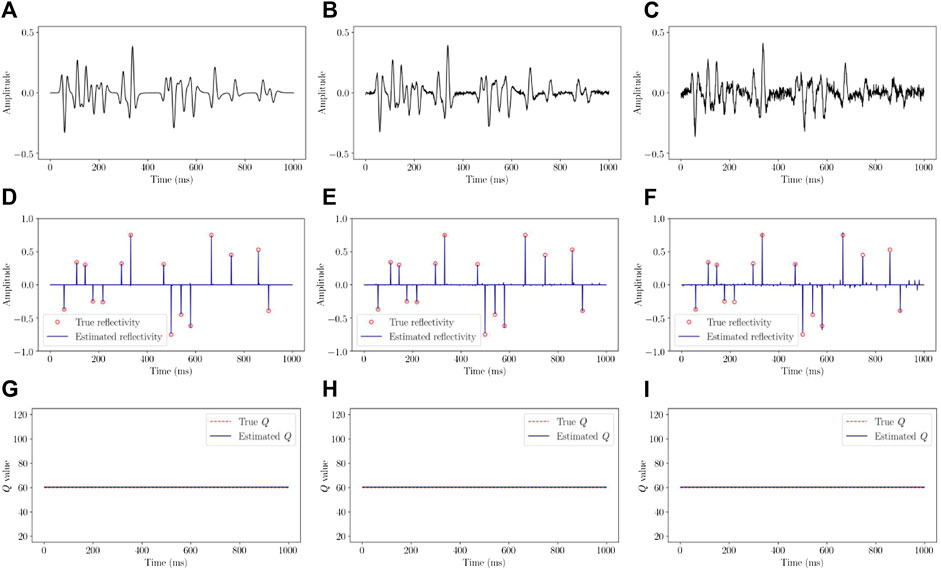
FIGURE 4. Complex synthetic traces attenuated by using constant-Q model (Q = 60) and contaminated by random noises of different levels: (A) 0.1%, (B) 5%, and (C) 10%. The estimated reflectivity series are shown in (D–F). The true non-zero reflectivity coefficients are shown by the red points. The corresponding estimations of the Q values are showed in (G–I). The true Q values are shown in red lines.
3.2 Seismic reflectivity and Q estimation of the interval-Q model
We next test the performance of the new method for seismic reflectivity and Q estimation of the interval-Q model. Similar to the previous examples, some synthetic traces have been generated by convolving the reflectivity with a Ricker wavelet of dominant frequency 35 Hz, and then different random noises have been added to the resulting traces. The new method is applied to these synthetic traces for the reflectivity and interval-Q estimation. Algorithm 1 is performed for thirty logarithmically spaced Q values in the range [10, 120].
Figures 5A–C shows the simple synthetic traces attenuated by using the different interval-Q models and contaminated by the 0.1% random noises. Here, the reflectivity series of 0.3, 0.4, −0.6, 0.7, −0.6, 0.4 and 0.3 are set at 111, 222, 333, 500, 666, 777, and 888 ms respectively, and no interference occurred between the reflections. The estimated reflectivity series are shown in Figures 5D–F. The corresponding estimations of the Q values are showed in Figures 5G–I.
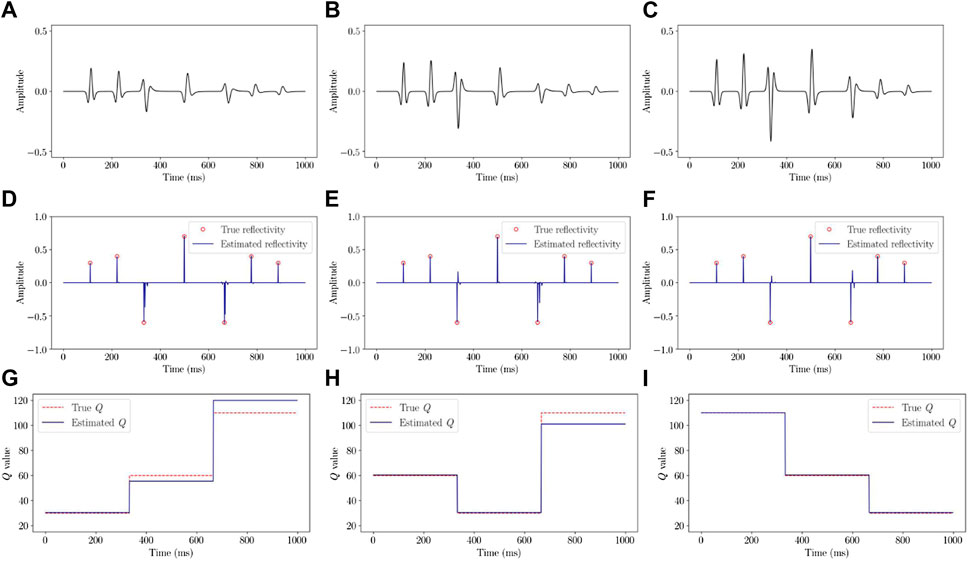
FIGURE 5. Simple synthetic traces attenuated by using interval-Q model with different Q values: (A) Q = (30, 60, 110), (B) Q = (60, 30, 110), and (C) Q = (110, 60, 30). The estimated reflectivity series are shown in (D–F). The true non-zero reflectivity coefficients are shown by the red points. The corresponding estimations of the Q values are showed in (G–I). The true Q values are shown in red lines.
Figures 6A–C shows the complex synthetic traces attenuated by using the interval-Q model (Q = 60, 30, 110) and each contaminated by random noises of different levels (0.1%, 5% and 10%). Here, the high reflections are set at 333, 500, and 666 ms, and the corresponding reflection coefficients are 0.7, −0.7 and 0.7, respectively. At other times, the reflection coefficients are set randomly. The complex synthetic traces contain some reflection interferences from the adjacent reflections. The final obtained reflectivity series are shown in Figures 6D–F. The corresponding estimations of the Q values are showed in Figures 6G–I.
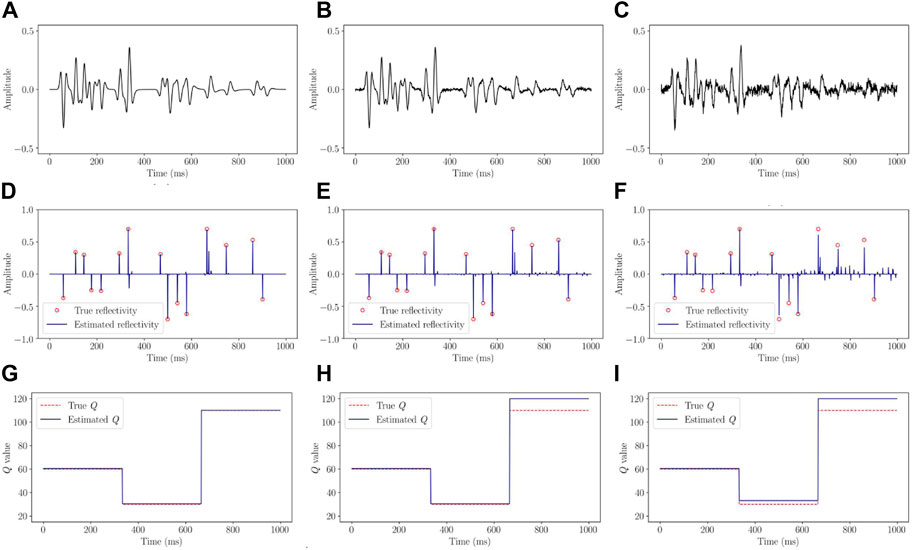
FIGURE 6. Complex synthetic traces attenuated by using interval-Q model (Q = 60, 30, 110) and contaminated by random noises of different levels: (A) 0.1%, (B) 5%, and (C) 10%. The estimated reflectivity series are shown in (D–F). The true non-zero reflectivity coefficients are shown by the red points. The corresponding estimations of the Q values are showed in (G–I). The true Q values are shown in red lines.
As seen from these results, the estimations of the reflectivity series are very accurate and the estimated Q values are relatively close to the true values in all the cases. Furthermore, the accuracy of the estimates is related to the noise level, which decreases as the noise level increases under normal circumstances. The new method improves the resolution by removing the wavelet and attenuation effects even in the case of high-level noises, especially at places with great attenuation effects.
For comparison, we also perform the Gabor deconvolution (Margrave et al., 2011) for the reflectivity estimation corresponding to the synthetic traces shown in Figures 6A–C. The Gabor deconvolution estimates and corrects for the effects of source wavelet and anelastic attenuation (Margrave et al., 2011). The corresponding estimated reflectivity series are shown in Figure 7. It is clearly seen from Figures 6, 7 that the accuracy of the reflectivity estimation by the Gabor deconvolution is not better than that by our proposed method.

FIGURE 7. The estimated reflectivity series by the Gabor deconvolution. (A) The estimated reflectivity series corresponding to the synthetic traces shown in Figure 6A. (B) The estimated reflectivity series corresponding to the synthetic traces shown in Figure 6B. (C) The estimated reflectivity series corresponding to the synthetic traces shown in Figure 6C. The true non-zero reflectivity coefficients are shown by the red points.
In addition, we compare the proposed method with the conventional spectral ratio method (Hauge, 1981) for the Q estimation. The results of the Q estimation are reported in Table 1. It can be seen from Table 1 that the proposed method provides more accurate Q values than the spectral ratio method in all cases. The new method uses both the amplitude and phase information of the attenuation operator, and regularizes the estimated Q by the sparsity information of the seismic reflectivity series. However, the conventional spectral ratio method only uses the amplitude information to determine the Q value, and the spectral interference from the adjacent reflections limits it (Xue et al., 2020). Hence, the Q values estimated by the new method are more accurate than the results provided by the conventional spectral ratio method.

TABLE 1. The results of the Q estimation by different methods, corresponding to the synthetic traces shown in Figures 6A–C.
4 Real data examples
Finally, we test the performance of the new method with two sets of real stacked seismic data shown in Figures 8A, 9A. The geometric spreading correction and the simple de-noising process have been operated for the real data. The real data represent the 2D poststack sections with the high signal-to-noise ratio and look clean. The seismic wavelet can be extracted from the early part of the data using the blind deconvolution method (Gholami and Sacchi, 2013). In general, the signal can be segmented according to the rough horizon in the seismic data. For computational purposes, the numbers of Q-layers 9 and 5 are assumed for the two sets of real stacked seismic data respectively. For each data set, thirty Q values in the range [20, 400] in logarithm scale are selected to run Algorithm 1. The resulting reflectivity sections are depicted in Figures 8B, 9B, which show the vertical resolution has been greatly improved by the new method, and provide the structural and stratigraphic features in great details. The vertical resolution achieved by the new method is significant and it may have important effects in seismic reservoir characterization of thin layers. The estimated Q models by the proposed method are shown in Figures 8C, 9C. The estimated Q models by the conventional spectral ratio method are shown in Figures 8E, 9E. We perform the inverse Q filtering (Wang, 2006) of the data using the generated Q models. The resulting seismic sections after inverse Q filtering using the estimated Q model by the proposed method are shown in Figures 8D, 9D. The resulting seismic sections after inverse Q filtering using the estimated Q model by the conventional spectral ratio method are shown in Figures 8F, 9F. These resulting seismic sections clearly show improvements in the vertical resolution and more details on stratigraphic features compared to the raw data. Furthermore, it can be seen from these figures that the improved resolution using the estimated Q model by the proposed method is better than the one by the conventional spectral ratio method.
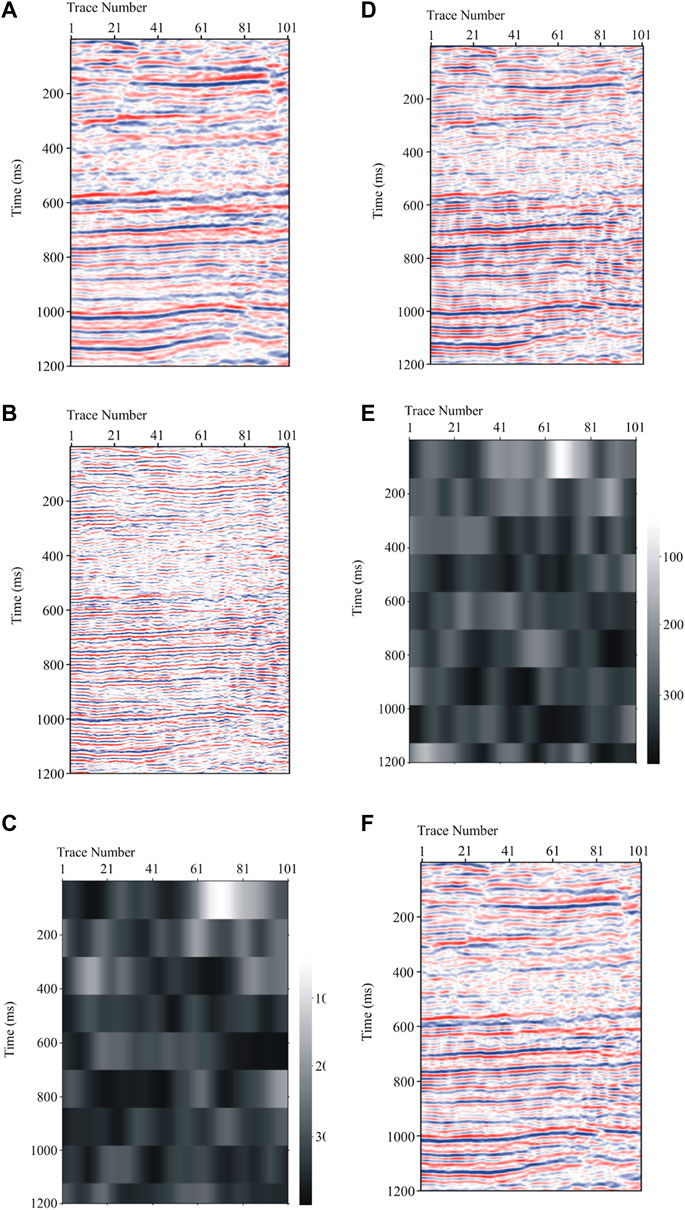
FIGURE 8. (A) A stacked seismic data set, (B) estimated reflectivity section by the proposed method, (C) estimated Q model by the proposed method, (D) seismic section after inverse Q filtering using the estimated Q model by the proposed method, (E) estimated Q model by the conventional spectral ratio method, and (F) seismic section after inverse Q filtering using the estimated Q model by the conventional spectral ratio method.
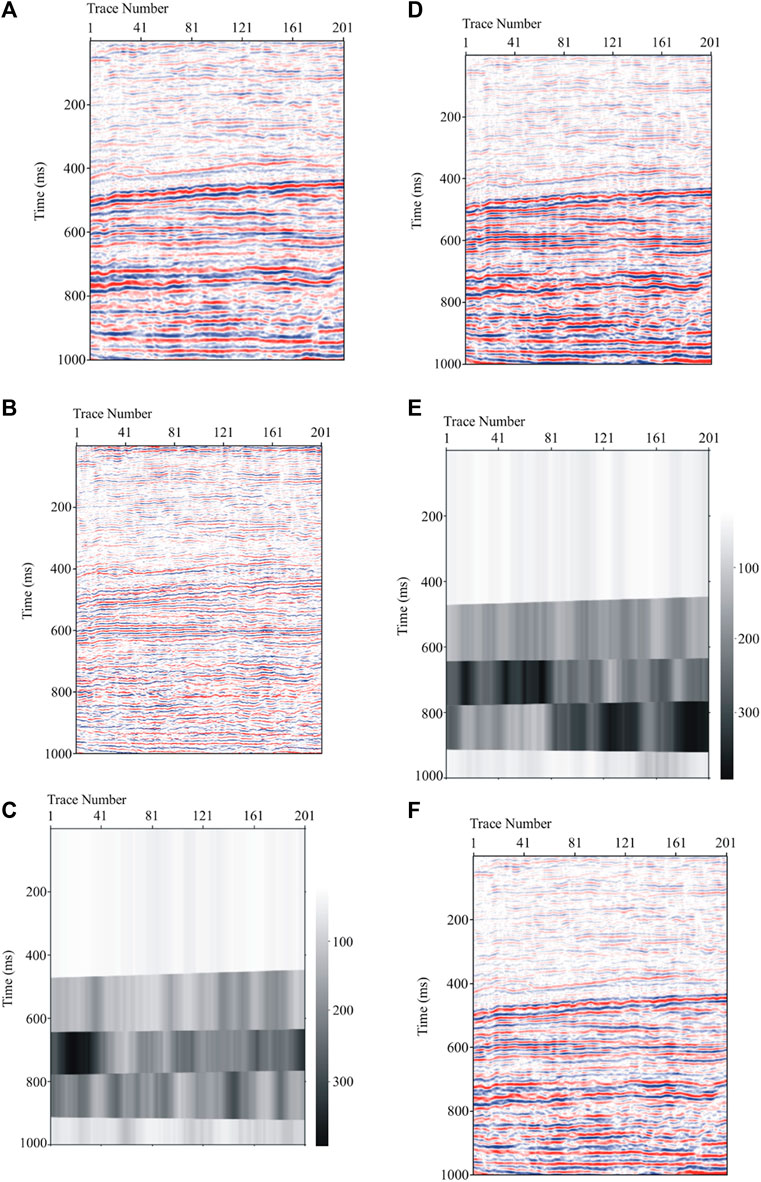
FIGURE 9. (A) A stacked seismic data set, (B) estimated reflectivity section by the proposed method, (C) estimated Q model by the proposed method, (D) seismic section after inverse Q filtering using the estimated Q model by the proposed method, (E) estimated Q model by the conventional spectral ratio method, and (F) seismic section after inverse Q filtering using the estimated Q model by the conventional spectral ratio method.
5 Discussion
In general, the performance of Q estimation methods from seismic data decreases with increasing wavelet interference and noise level (Tu and Lu, 2010; Aghamiry and Gholami, 2018). Our proposed method uses both the amplitude and phase information of the attenuation mechanism, and regularizes the estimated Q model by the sparsity constraint of the seismic reflectivity, but it is also affected by the high-level noises. The accuracy of the estimates decreases as the noise level increases. Therefore, the de-noising process is necessary for the real data with low signal-to-noise ratio. In addition, the proposed method is implemented in a trace by trace manner and takes no account of the lateral continuity. The method of the multichannel form may provide better results.
6 Conclusion
In this paper, we have presented a new method for concurrent estimation of seismic reflectivity and Q by using optimal dictionary learning. This new method first constructs a complete dictionary based on the non-stationary convolution model, then computes the reflectivity series under different dictionary matrices with the corresponding referencing Q values, and finally selects the optimal dictionary matrix by comprehensively analyzing the residual and reflectivity sparsity so as to obtain seismic reflectivity and Q concurrently. Synthetic examples using simulated data demonstrate that the proposed method provides accurate estimation of seismic reflectivity and Q, and improves the resolution by removing the wavelet and attenuation effects. Furthermore, the examples of real data also confirm the effectiveness of the proposed method, which improves the vertical resolution without losing weak events and provides more accurate information concerning stratigraphic features in great details. Thus, the presented method is very useful to improve the vertical resolution and enhance the reservoir identification in seismic processing and interpretation.
Data availability statement
The original contributions presented in the study are included in the article/supplementary material, further inquiries can be directed to the corresponding author.
Author contributions
HYa and HYu studied the method and processed the data. HYa and TX performed the data analysis. HYa wrote and revised the manuscript.
Funding
This work was supported by the National Natural Science Foundation of China (Grant Nos. 92055213 and 41874160), by the Youth Innovation Promotion Association of CAS (2018093), and by the Key Research Program of the Institute of Geology and Geophysics, CAS (Grant No. IGGCAS-201903).
Conflict of interest
The authors declare that the research was conducted in the absence of any commercial or financial relationships that could be construed as a potential conflict of interest.
Publisher’s note
All claims expressed in this article are solely those of the authors and do not necessarily represent those of their affiliated organizations, or those of the publisher, the editors and the reviewers. Any product that may be evaluated in this article, or claim that may be made by its manufacturer, is not guaranteed or endorsed by the publisher.
References
Aghamiry, H. S., and Gholami, A. (2018). Interval-Q estimation and compensation: An adaptive dictionary-learning approach. Geophysics 83 (4), V233–V242. doi:10.1190/geo2017-0001.1
Aki, K., and Richards, P. G. (1980). Quantitative seismology: Theory and methods. New York: University Science Books.
Blias, E. (2012). Accurate interval Q-factor estimation from VSP data. Geophysics 77 (3), WA149–WA156. doi:10.1190/geo2011-0270.1
Brzostowski, M., and McMechan, G. (1992). 3D tomographic imaging of near-surface seismic velocity and attenuation. Geophysics 57 (3), 396–403. doi:10.1190/1.1443254
Chai, X., Wang, S., Yuan, S., Zhao, J., Sun, L., and Wei, X. (2014). Sparse reflectivity inversion for nonstationary seismic data. Geophysics 79 (3), V93–V105. doi:10.1190/geo2013-0313.1
Dutta, G., and Schuster, G. T. (2016). Wave-equation Q tomography. Geophysics 81 (6), R471–R484. doi:10.1190/geo2016-0081.1
Engelhard, L. (1996). Determination of seismic-wave attenuation by complex trace analysis. Geophys. J. Int. 125 (2), 608–622. doi:10.1111/j.1365-246X.1996.tb00023.x
Futterman, W. I. (1962). Dispersive body waves. J. Geophys. Res. 67 (13), 5279–5291. doi:10.1029/JZ067i013p05279
Gao, J., and Yang, S. (2007). On the method of quality factors estimation from zero-offset VSP data. Chin. J. Geophys. (in Chinese) 50 (4), 1026–1040. doi:10.1002/cjg2.1120
Gholami, A., and Sacchi, M. D. (2013). Fast 3D blind seismic deconvolution via constrained total variation and GCV. SIAM Journal on Imaging Sciences 6 (4), 2350–2369. doi:10.1137/130905009
Gholami, A. (2015). Semi-blind nonstationary deconvolution: Joint reflectivity and Q estimation. Journal of Applied Geophysics 117, 32–41. doi:10.1016/j.jappgeo.2015.02.030
Hackert, C. L., and Parra, J. O. (2004). Improving Q estimates from seismic reflection data using well-log-based localized spectral correction. Geophysics 69 (6), 1521–1529. doi:10.1190/1.1836825
Hauge, P. S. (1981). Measurements of attenuation from vertical seismic profiles. Geophysics 46 (11), 1548–1558. doi:10.1190/1.1441161
Hu, C., Tu, N., and Lu, W. (2013). Seismic attenuation estimation using an improved frequency shift method. IEEE Geoscience and Remote Sensing Letters 10, 1026–1030. doi:10.1109/LGRS.2012.2227933
Kjartansson, E. (1979). Constant Q-wave propagation and attenuation. Journal of Geophysical Research 84, 4737–4748. doi:10.1029/JB084iB09p04737
Li, H., Greenhalgh, S., Chen, S., Liu, X., and Liu, B. (2020). A robust Q estimation scheme for adaptively handling asymmetric wavelet spectrum variations in strongly attenuating media. Geophysics 85 (4), V345–V354. doi:10.1190/geo2019-0442.1
Margrave, G. F., Lamoureux, M. P., and Henley, D. C. (2011). Gabor deconvolution: Estimating reflectivity by nonstationary deconvolution of seismic data. Geophysics 76 (3), W15–W30. doi:10.1190/1.3560167
Margrave, G. F. (1998). Theory of nonstationary linear filtering in the Fourier domain with application to time-variant filtering. Geophysics 63 (1), 244–259. doi:10.1190/1.1444318
Matsushima, J., Ali, M. Y., and Bouchaala, F. (2016). Seismic attenuation estimation from zero-offset VSP data using seismic interferometry. Geophysical Journal International 204 (2), 1288–1307. doi:10.1093/gji/ggv522
McDonal, F. J., Angona, F. A., Mills, R. L., Sengbush, R. L., Van Nostrand, R. G., and White, J. E. (1958). Attenuation of shear and compressional waves in Pierre shale. Geophysics 23 (3), 421–439. doi:10.1190/1.1438489
Nakata, R., Lumley, D., Hampson, G., Nihei, K., and Nakata, N. (2020). Waveform-based estimation of Q and scattering properties for zero-offset vertical seismic profile data. Geophysics 85 (4), R365–R379. doi:10.1190/geo2019-0369.1
Quan, Y., and Harris, J. M. (1997). Seismic attenuation tomography using the frequency shift method. Geophysics 62 (3), 895–905. doi:10.1190/1.1444197
Reine, C., Clark, R. A., and van der Baan, M. (2012). Robust prestack Q-determination using surface seismic data — Part 1: Method and synthetic examples. Geophysics 77 (1), R45–R56. doi:10.1190/geo2011-0073.1
Robinson, E. A. (1967). Predictive decomposition of time series with application to seismic exploration. Geophysics 32 (3), 418–484. doi:10.1190/1.1439873
Shao, J., Wang, Y., and Chang, X. (2019). “Simultaneous inversion of Q and reflectivity using dictionary learning,” in 89th annual international meeting, SEG, expanded abstracts, 595–599. doi:10.1190/segam2019-3216031.1
Tonn, R. (1991). The determination of the seismic quality factor Q from VSP data: A comparison of different computational methods. Geophysical Prospecting 39 (1), 1–27. doi:10.1111/j.1365-2478.1991.tb00298.x
Tu, N., and Lu, W.-K. (2010). Improve Q estimates with spectrum correction based on seismic wavelet estimation. Applied Geophysics 7 (3), 217–228. doi:10.1007/s11770-010-0252-2
Velis, D. R. (2008). Stochastic sparse-spike deconvolution. Geophysics 73 (1), R1–R9. doi:10.1190/1.2790584
Wang, Y. (2004). Q analysis on reflection seismic data. Geophysical Research Letters 31 (17), L17606. doi:10.1029/2004GL020572
Wang, Y. (2006). Inverse Q-filter for seismic resolution enhancement. Geophysics 71 (3), V51–V60. doi:10.1190/1.2192912
Wang, Y. (2014). Stable Q analysis on vertical seismic profiling data. Geophysics 79 (4), D217–D225. doi:10.1190/geo2013-0273.1
White, R. (1980). Partial coherence matching of synthetic seismograms with seismic traces. Geophysical Prospecting 28 (3), 333–358. doi:10.1111/j.1365-2478.1980.tb01230.x
Winkler, K. W., and Nur, A. (1982). Seismic attenuation: Effects of pore fluids and frictional sliding. Geophysics 47 (1), 1–15. doi:10.1190/1.1441276
Xue, Y.-J., Cao, J.-X., Wang, X.-J., and Du, H.-K. (2020). Estimation of seismic quality factor in the time-frequency domain using variational mode decomposition. Geophysics 85 (4), V329–V343. doi:10.1190/geo2019-0404.1
Yang, D., Liu, J., Li, J., and Liu, D. (2020). Q-factor estimation using bisection algorithm with power spectrum. Geophysics 85 (3), V233–V248. doi:10.1190/geo2018-0403.1
Keywords: seismic reflectivity, seismic attenuation, quality factor, non-stationary convolution, dictionary learning
Citation: Yan H, Yu H and Xu T (2023) Concurrent estimation of seismic reflectivity and Q by using an optimal dictionary learning method. Front. Earth Sci. 11:1121956. doi: 10.3389/feart.2023.1121956
Received: 12 December 2022; Accepted: 02 January 2023;
Published: 19 January 2023.
Edited by:
Gang Yao, China University of Petroleum, ChinaCopyright © 2023 Yan, Yu and Xu. This is an open-access article distributed under the terms of the Creative Commons Attribution License (CC BY). The use, distribution or reproduction in other forums is permitted, provided the original author(s) and the copyright owner(s) are credited and that the original publication in this journal is cited, in accordance with accepted academic practice. No use, distribution or reproduction is permitted which does not comply with these terms.
*Correspondence: Hongyong Yan, eWFuaG9uZ3lvbmdAbWFpbC5pZ2djYXMuYWMuY24=
 Hongyong Yan
Hongyong Yan Hui Yu1,2,3
Hui Yu1,2,3